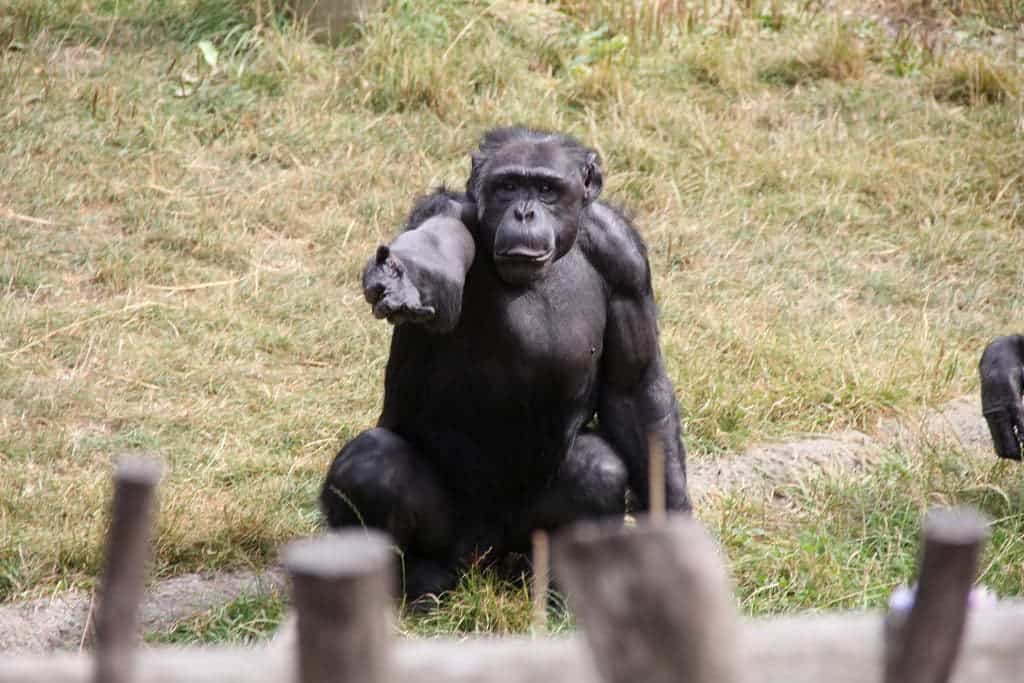Our language is one of the features that define us as human beings and distance us from all other animals. Though no other species has developed language like us, animals communicate with each other through a vast set of signals.

In the case of great apes, they communicate by vocalizations, facial expressions, body displays or gestures. Due to the phylogenetic proximity between humans and great apes, the study of gestural communication is particularly attractive since it allows to hypothesize how language evolved in our species. And the evolution of human language is one of the hardest scientific topics to do research. The reason is simple: language does not fossilize. That is why we are forced to look for other clues to enlight us about how our language evolved and great ape gestures can lead us much further in the search for answers than we previously thought.
First of all, great apes employ gestures in an intentional, flexible and goal-oriented ways and display them in various contexts like grooming, playing or feeding. For example, to request food, great apes usually use begging gestures in which they stretch their arms and open their hands towards other conspecific with food.
But why gestures can be considered as a precursor of human language? Well, neuroscience brought some interesting and strong findings but is not my intention discuss that kind of gestural theories based on brain data. Instead, I’m going to take a quick look at robust data collected during long-term field studies conducted in different study sites. Yeah, we already know that in our ontogenetic path, before we speak, we communicate to the world using gestures. In our species, gestures emerge first. Speech appears later. But this is not the proof that tickles my guts!
There is no doubt that great ape gestures are flexible. All scientific papers about primate gestural communication support this evidence. Same gesture for different purposes and different gestures for the same purpose. Pretty much similar to what we do with our spoken language. Different words for the same meaning and vice versa. So, we can highlight that apes communicate different things in very different situations.
One particular paper, written by Amy Pollick and Frans de Waal, reports an outstanding discovery: the gestural repertoire varies from group to group of the same species, in some kind of gestural dialect. Some gestures were only observed in particular circumstances and at one study site. Once again, pretty much similar to our language. Moreover, and in a broader view, Graham et al. (2017) made a diagram about gestural repertoires of chimpanzees (Pan troglodytes) and bonobos (Pan paniscus) and these two great ape species share a very significant amount of gestures while some of them are unique to each species. Such striking overlap of gestures and, at the same time, the still more mind-blowing exclusivity of some gestures between chimpanzees and bonobos reveals us a scenario in which, most likely, the different languages of today evolved from an ancestral language. We are biologically programmed to speak but our language evolved itself in a cultural way, as apparently occurs with great ape gestures.
Furthermore, Hobaiter & Byrne (2014), focused on an attempt to translate the meaning of chimpanzee gestures. At the first glance, it may seem and exaggerated anthropocentric approach, trying to humanize all animal behavior. But for those who have spent many hours observing great apes gestural communication (like me), the similarities between human and great ape gestures pop out at you. So, in the paper cited above, the authors identified some gestures that sound us like “move away”, “please, groom me”, “stop that” or “follow me”.
Will be the great ape’s gestural communication the holy grail to understand the roots of human language? I guess so. The growing body of evidence that comes to us from primatological studies are quite exciting and it makes me very optimistic to solve the riddle of the evolution of our language. We need to keep collect data and test some hypothesis.
References:
Pollick, A. S.; de Waal, F. B. M. (2007). Ape gestures and language evolution. PNAS, 104(19), 8184-8189;
Hobaiter, C.; Byrne, R. W. (2014). The meanings of chimpanzee gestures. Current Biology, 24(14), 1596-1600;
Graham, K. E.; Furuichi, T.; Byrne, R. W. (2017). The gestural repertoire of the wild bonobo (Pan paniscus): a mutually understood communication system. Animal Cognition, 20(2), 171-177;


